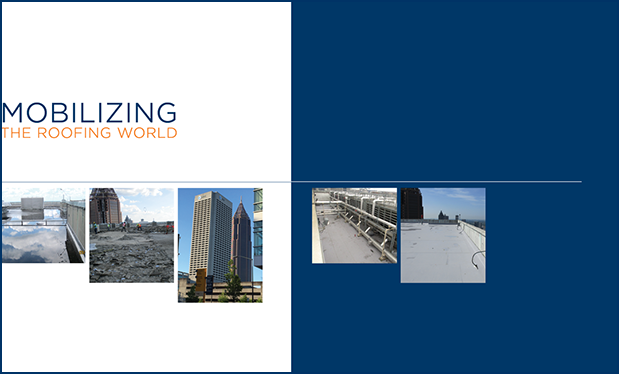Illinois contractor faces $281,286 in proposed penalties
The Occupational Safety and Health Administration (OSHA) has cited Manuel Gallardo, owner of Gallardo's Construction Services, Palatine, Ill., for multiple safety hazards, according to www.osha.gov. Gallardo's Construction Services faces proposed penalties totaling $281,286. The company is not an NRCA member.
OSHA inspectors observed Gallardo's employees exposed to fall hazards during six Chicago-area residential roofing projects between August and November 2017. OSHA issued citations for four willful and three repeated violations for Gallardo's failure to install fall-protection systems, ensure the use of protective devices and train his employees regarding fall-protection hazards. Gallardo also was cited for nine serious violations for allowing his employees to operate nail guns without eye protection and failing to conduct job-site inspections.
"Employers are required to provide safe workplaces for their employees," says Kathy Webb, OSHA's Chicago south area office director. "This employer's continual disregard of fall protection requirements is exposing employees to potentially serious injuries."
Gallardo's Construction Services has 15 days from receipt of its citations and penalties to comply, request an informal conference with OSHA's area director or contest the findings before the independent Occupational Safety and Health Review Commission.
OSHA proposes targeting "high-risk" workplaces for inspections
The Occupational Safety and Health Administration (OSHA) has proposed targeting "high-risk" workplaces during fiscal year 2019, which would result in fewer inspections in less hazardous industries, according to Bloomberg BNA.
OSHA's enforcement plan in the White House budget request says OSHA would conduct 30,840 inspections during fiscal year 2019, a decrease from 32,396 inspections conducted during fiscal year 2017. The proposed number of inspections would be the fewest inspections since 1996.
Worker advocates argue the proposal is "creating a false choice" between inspecting high-risk job sites or maintaining overall inspection numbers. Others support the proposal, saying OSHA inspectors won't waste time visiting companies that have few substantial hazards.
If employees at a business aren't complaining to OSHA and the business isn't covered by an OSHA emphasis program targeting a specific hazard or industry, OSHA likely won't inspect the business, according to Micah Smith, a partner at Conn Maciel Carey LLP in Washington, D.C.
OSHA also is asking for $212.7 million for federal enforcement efforts during fiscal year 2019—a $4.7 million increase from OSHA's fiscal year 2017 spending. OSHA would use some of the funding to add seven enforcement positions.
OSHA's move toward increased inspections in high-hazard workplaces began during the Obama administration when OSHA measured its fiscal year inspections by using a rating system that would indicate the time and personnel needed to conduct an inspection or whether the hazard or industry was an OSHA priority. For fiscal year 2019, OSHA is proposing adding another way to measure its activities—the OSHA Enforcement Weighting System; details are not yet available regarding how the system would work.
Court rules no statutory limitation for repeat safety violations
The Occupational Safety and Health Administration (OSHA) can look back more than three years for a repeat safety violation, emphasizing there is no statutory limitation regarding the length of time OSHA can use a previous citation for that purpose, according to Bloomberg BNA.
This was reaffirmed during a recent ruling by the U.S. Court of Appeals for the Second Circuit after OSHA cited Triumph Construction Corp., New York City, for repeatedly violating safety standards before a 2014 trench collapse. The company challenged the citation, saying OSHA's Field Operations Manual set a three-year look-back period for establishing a repeated violation and that the three-year time frame also was part of review commission policy.
However, the court found the manual only is a general guide that does not bind the agency or the commission, saying the Occupational Safety and Health Act and its implementing regulations do not "prescribe any temporal limits for determining whether a violation is repeated."
Eric Conn, a safety and health attorney at Conn Maciel Carey LLP in Washington, D.C., says OSHA officials historically used the three-year period set in the manual, but under the Obama administration, OSHA looked for ways to boost the number of repeat citations. The lack of time restrictions makes it more important for employers to take steps to avoid violations and consider the risk of repeat citations, which can lead to placement in OSHA's Severe Violator Enforcement Program.
Employers reminded to post OSHA's Form 300A
The Occupational Safety and Health Administration (OSHA) is reminding employers of their obligation to post a copy of OSHA's Form 300A, which summarizes job-related injuries and illnesses logged during 2017.
Between Feb. 1 and April 30 each year, employers must display Form 300A in a common area where notices to employees typically are posted. Businesses with 10 or fewer employees and those in certain low-hazard industries are exempt from OSHA record-keeping and posting requirements.
Additional information about OSHA's record-keeping requirements is available by clicking here.



